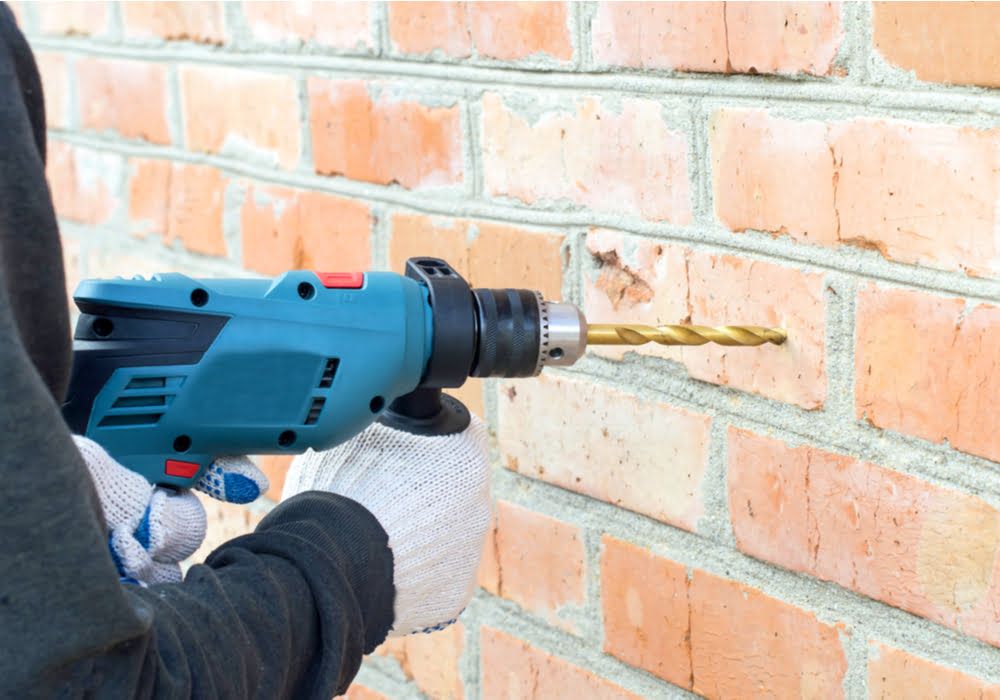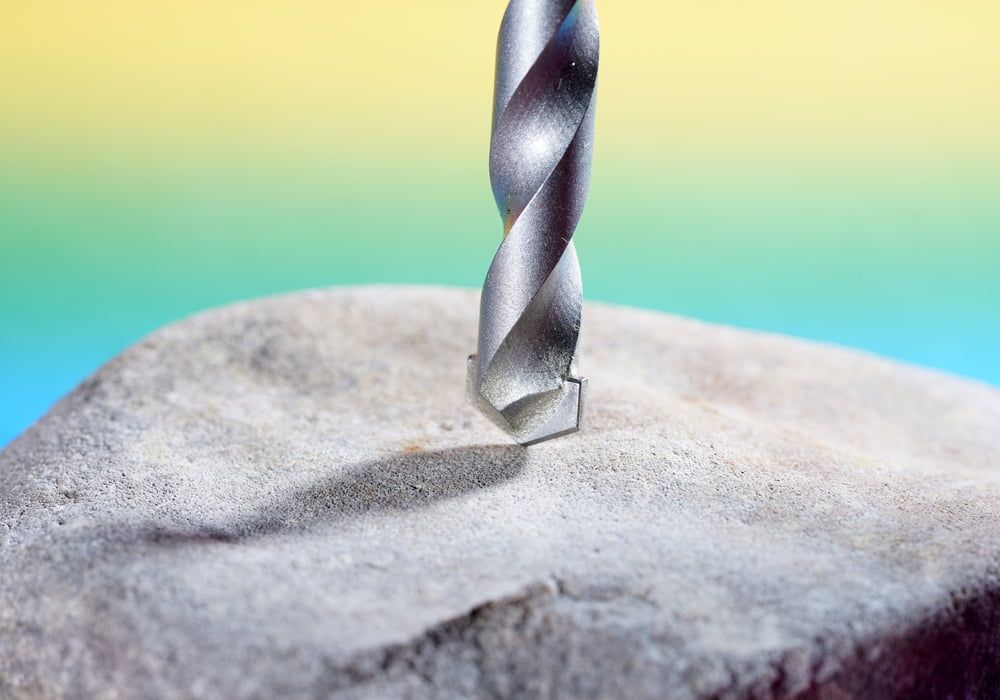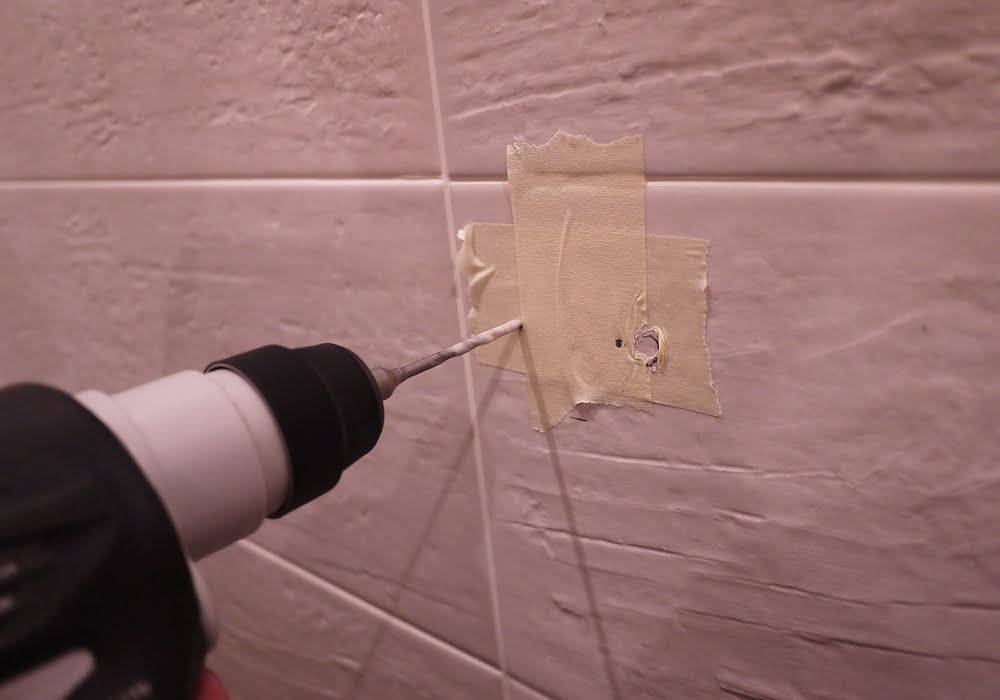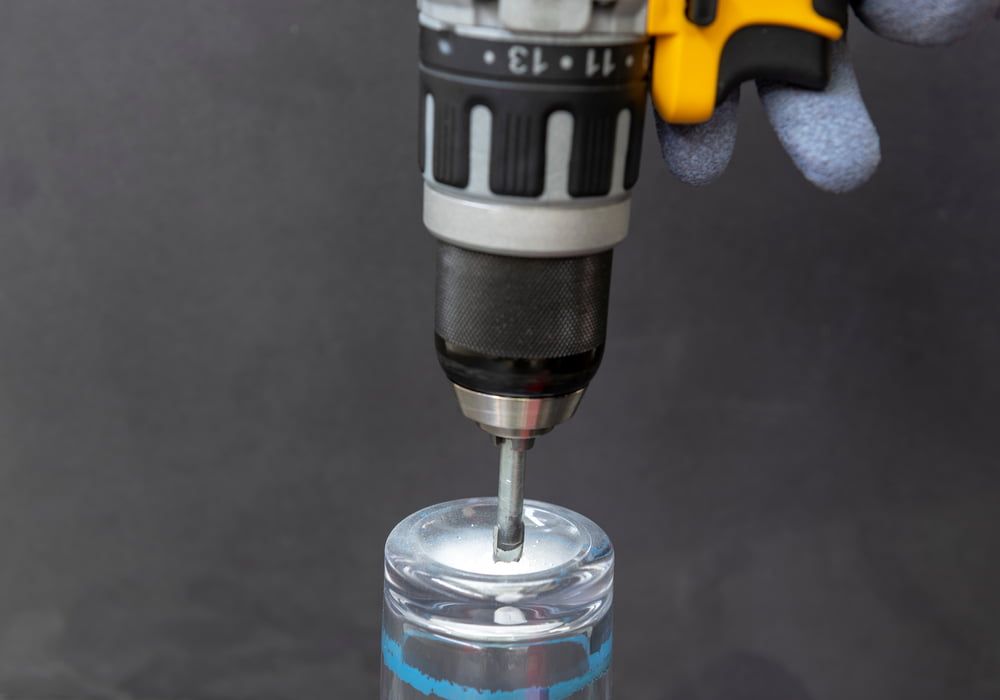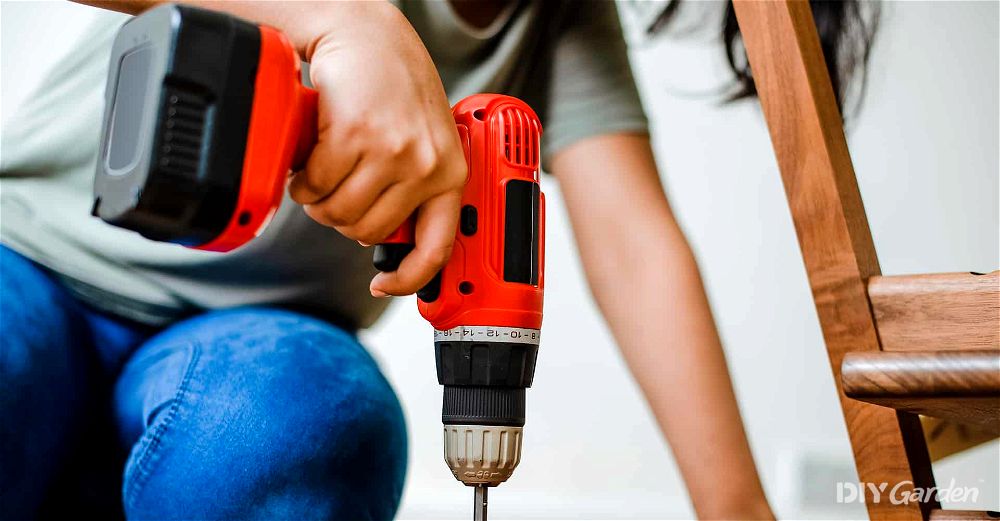
As the foundation of almost every project from home décor and crafty endeavours to larger scale renovation plans, drilling is a skill that you can’t afford not to learn.
For a DIY amateur, a drill is the most versatile tool you can own, and a decent model will take you far.
Drilling sounds relatively straightforward, but decent equipment alone won’t guarantee an excellent finish.
Perfect drilling requires finesse, attention to detail, and perhaps most importantly, a certain amount of patience, which is difficult when you’re anxious to have a job done and dusted!
A rushed or inexperienced drill job will cost you time, materials and drill bits. And let’s face it, who wants to sit staring at a botched tile or crooked picture until the end of days?
Fortunately, our comprehensive guide to drilling will spare you the pain, all you need to do is read on!
This Guides Covers How to Drill Into…
- Wood
- Masonry
- Plaster
- Concrete
- Stone
- Metal
- Tiles
- Glass
Before You Start
Regardless of the material you intend on drilling through, there are a few safety measures that need to be taken across the board when using a drill.
The rotating action of a drill can become entangled easily in loose clothing and jewellery, so remove anything baggy or dangling before beginning.
Goggles and form-fitting work gloves protect your eyes and hands from splinters and flying debris, and a dust mask prevents the inhalation of harmful particles.
As a general rule of thumb, any tool that is loud enough to drown out regular conversation can be harmful to your ears, so ear defenders are also a good idea.
Check Before You Drill
Before drilling into any surface, you should always check what’s on the other side. Obviously, this is easy if you are drilling holes in glass or sheets of metal, but if you are drilling into a cavity wall or stud partition, it complicates matters a bit.
The most common culprits lurking behind walls are pipes, cables and electrical wires, so drilling blindly risks flooding, electrocution, damage to the heating system or (even worse!) severing your cable tv or internet connection.
There are no constants to where these pipes are run, so it’s always important to check before you drill. Thankfully, you don’t need psychic powers to find out what’s behind your walls. A pipe and live wire detector is a handy little gadget that will do all the guessing for you. All you need to do is hold it to the wall and press a button, and it will indicate the presence of anything you shouldn’t drill through.
How to Drill into Wood
Drilling into wood is a prerequisite in so many crafts and carpentry projects, and if you own a drill, chances are you have drilled into wood at some stage. Here are a few tips that could make your life easier!
A standard drill driver is the best power drill for drilling into wood. Although drill drivers do not have a built-in hammer function that is necessary for drilling into masonry, they do come with torque control. This is effectively a clutch setting that determines how much power (not speed) can be applied to the task. You can find out more about the difference between torque and speed here.
Standard drill bits are fine for drilling through wood. Depending on the size, shape, and purpose of the hole you wish to drill, specialized bits are available to make life easier. Spade bits drill holes with a larger diameter, Forstner bits are ideal for creating holes with precise flat bottoms, and speed bore bits have augers that help to remove the waste from the hole.
Measure the diameter of the hole and mark its position on the wood with a centre punch.
Predrilling pilot holes into wood before actually drilling the screws reduces the chances of the wood splitting. It also prolongs the life and fastening power of the screw.
Clamping is a recommended safety measure that prevents the bit from sticking and spinning the work piece. If using a handheld drill, clamping also stops the drill from flying out of your hand if the drill bit catches.
Start drilling slowly, and once the bit has entered the wood, increase the speed, exerting as little pressure as possible. The drill should be guiding you, rather than the other way around.
Once the hole is drilled, the edges can be smoothed by sanding, or by using a deburring tool.
Hacks for Drilling into Wood
- Generally, large wide screws work better with a higher torque setting, whereas smaller thinner screws favour a lower clutch setting.
- Old CD’s make great tools for drilling straight holes! Place the inner hole of the CD over the point you wish to drill through, with the reflective surface facing upwards, and position the drill in line with its reflection to ensure that you are drilling a perfect hole.
How to Drill into Brick or Masonry
Drilling into brick or masonry is no mean feat. This high density material requires a power drill with a hammer action to penetrate it. Hammer drills, combi drills (combi drills are cordless hammer drills) and SDS rotary hammer drills are the best power tools for this purpose. Drill drivers are not suitable. The rapid hammer action fractures the material whilst the drill flutes scoop out the waste.
Regular drill bits are nowhere near robust enough to bore through brickwork and masonry, so you will need to buy specific masonry bits. Masonry bits are identifiable by their triangular tip. Tungsten carbide masonry drill bits with diamond cut edges are most suited to drilling into brickwork.
Decide how wide and deep the hole needs to be. Remember, if you put a screw in the wall to hang something on, a wall anchor (aka rawlplug) is necessary to secure it. Take the size of the anchor into consideration when planning the width of the hole.
Mark the spot on the wall where you intend to drill. If you can try and drill through the mortar between the bricks, rather than the mortar itself, as it is easier to pierce. Drilling directly into brick can weaken its structure and increase the likelihood of shattering.
Before you begin drilling, make sure you have done your homework. Check for any pipes, wires or cables that may be behind the wall.
Begin drilling in small bursts to form a shallow hole, before increasing the power. Switch on the drill’s hammer action and gradually add more force.
While working, hold the drill straight at a 90-degree angle to the wall. Take regular breaks to avoid muscle fatigue and the risk of drill slippage.
For larger holes you may need to use a smaller drill bit to drill a pilot hole, before enlarging the hole with a bigger drill bit.
If you require a large hole to run a pipe for example, you will need a core bit. This is similar to a hole saw that is used with timber. A core bit cuts around the diameter of a hole rather than bores through it.
Hacks for Drilling into Brick or Masonry
- Drill too deep and you could end up losing your anchor in the wall. To ensure you get the depth of the hole correct, mark your drill bit 5 mm-10 mm longer than the length of the screw, and obviously stop drilling when you reach the mark.
- Keep your bits cool! Drilling through mortar is energy intensive, so the drill bit will become hot quickly. Keeping a pot of water nearby to dip it into will save waiting for it to cool down. Be careful not to get the body of the drill wet though!
- Holes drilled into brick can be resealed using putty, mortar repair or silicone.
How to Drill into Plaster
Whether you want to hang something on your plaster wall, or you want to build a stud wall by fixing drywall to a frame, the steps are the same.
Plaster and drywall are not as supportive as concrete or brick walls, so ideally you should try and fix your item to a stud frame located behind the plasterboard.
To locate the stud frame behind the board, you will need a stud finder. Stud finders are available as standalone tools, and also as multi-purpose gadgets that detect cables, wires and pipes.
If you are unable to use the stud wall to secure your item, and as long as the item to be supported is not too heavy, hollow wall or nylon toggle fixings are the solution. Their wide flute provides added support and security in the relatively flimsy plasterboard.
Mark the wall where you wish to drill, accounting for the maximum width of the fixing being used. Standard wood bits are fine for drilling through plaster.
Begin drilling slowly with a drill driver and standard drill bit and increase the drill speed as you enter the plaster. Once the hole is drilled insert the fixing.
How to Drill into Concrete
Concrete is even more dense than masonry so it is essential you have the right power drill for the job. For most DIY tasks an SDS rotary drill is the most efficient power tool for this purpose although hammer drills or combi drills can also be used. For more challenging work or demolishing concrete jack hammers or concrete breakers could also be used. Tungsten carbide masonry drill bits with diamond cut edges are most suited to drilling into concrete.
Decide on the width and depth of the hole you need, and mark the spot on the wall. Again double check that there are no pipes, cables or live wires lying in wait behind the concrete.
Begin by drilling a shallow hole on low power, before ramping it up a notch and engaging the hammer action on the drill.
If you are drilling a larger hole, start by making a pilot hole with a smaller bit before finishing it off with a larger one. This avoids putting stress on the surrounding concrete.
Hacks for Drilling into Concrete
- While drilling, retract the bit slightly every 10 seconds or so to remove the dust from the hole.
- If you hit an exceptionally hard patch of concrete, you can break through it by hammering a masonry nail into it, before continuing drilling. This will save your drill bits.
- Concrete debris can be removed from the hole using a hoover, or pressurised air in a can.
How to Drill into Stone
Natural stone is an incredibly hard and durable material, meaning you are lucky if your house is built from it, but unlucky if you ever need to drill a hole through it! However, with the right know-how, it can be done.
A hammer drill, combi drill or SDS rotary drill, along with a metal bonded diamond drill bit are the perfect tools for the job. For larger holes a diamond core makes the job easier.
Mark out the position of your hole. Stone walls are difficult to repair once drilled, so double check your measurements and positioning.
Enable the drill’s hammer feature if necessary and apply gentle and steady pressure as you begin to drill. Start slowly, increasing the speed as you go.
Hacks for Drilling into Stone
- Diamond drill bits should never feel hot to touch. Always ensure there is a water supply for lubrication.
- Drill bits sometimes become stuck in natural stone. If this happens, switch your drill off and reset it to rotate the bit anti-clockwise. Start the drill again using gentle power. This should dislodge the bit and you can revert to normal operation.
How to Drill into Metal
The day may come when you need to fix a curtain pole to a steel lintel or install a deadbolt on a steel door. If you didn’t pay attention during metalwork class all those years ago, here’s some advice now!
Whether you have a pillar drill and bench vice in your workshop or just a power or even hand drill, the following still applies. You should note that drilling into metal does not require the hammer action that drilling into brick, masonry or concrete does, so if you are using a drill with a hammer action be sure to turn it to rotary mode before drilling into metal.
For softer metals such as copper or aluminium, standard metal drill bits will suffice. However, if you are drilling a harder metal such as stainless steel, it’s worth investing in higher grade HSS bits, such as those coated with black oxide or cobalt. For softer metals, the drill bits should be flat to prevent tearing the metal, whereas harder materials require sharp tipped bits to minimize shavings. For ultimate accuracy in sheet metal, a step bit allows you to create a precise diameter with little effort.
Decide on the hole size and mark the spot you want to drill into. To prevent the drill wandering once commence drilling, create a dimple in the metal using a centre punch and a hammer.
Oiling your bit before starting prevents heat build-up and minimizes friction, which prolongs the life of the drill bit. Any multipurpose oil such as 3-in-1 will suffice, although there are more specialized cutting oils available.
Safety first! Any detached metal pieces should be clamped before drilling. Unlike wood, metal is extremely sharp and can be hazardous if not clamped correctly. If the drill bit sticks in an unsupported piece of metal, it could send it spinning, slicing through flesh. Don’t risk injury through laziness!
For larger holes, the metal should be predrilled using a smaller bit. ¼ inch is a good starting point for bigger holes, increasing until you reach the desired diameter.
Drilling as slowly as possible stops the bit overheating. In general terms, the harder the metal, the slower the drill speed.
Hacks for Drilling into Metal
- After drilling, smooth the sharp edges of the hole by taking a twist bit that has a wider diameter than the hole, and manually twisting it over the top of the hole.
- To make clean holes in sheet metal, sandwich the metal between two pieces of wood before clamping. This keeps the metal flat and stops the bit from wandering whilst drilling.
How to Drill into Tiles
Knowing how to drill into tiles is a handy skill for mounting mirrors and towel holders in your bathroom, or cutlery holders on your kitchen backsplash.
As with drilling through glass (see below), tile drilling requires a drill driver with a carbide tipped drill bit. Some diamond bits are also suitable.
The glossy tile surface means that great care must be taken to prevent the bit from slipping and causing injury or damage to the tile. Placing masking tape over the surface of the tile will provide traction and make it easier to drill safely.
Mark the spot you want to drill and begin drilling slowly and with very little pressure. Drill through the tile and into the drywall behind.
Use a hollow wall anchor to fix your screw in place.
Hacks for Drilling into Tiles
- Slow down the drill speed once you hit the drywall behind the tile. Accidentally drilling through it will mean that you can’t fix a wall anchor into the hole, rendering it useless.
- Beware of flying pieces of tile when drilling, as they can cause injury.
How to Drill into Glass
The thought of drilling into glass conjures up an image of screens shattering into a million pieces, spreading pointed shards across a wide radius. However, with the correct drill bit, making a hole in a mirror or piece of glass is almost as simple as drilling into any old block of wood. It just takes nerves of steel!
It should be noted that you cannot drill into tempered glass.
Carbide bits are necessary for glass drilling. For stronger glass such as wine bottles or glass blocks, a diamond bit is a better option. The glass must sit on a very firm surface.
Mark the spot you want to drill, and begin drilling slowly, using extremely light pressure as you go. Pressing too hard will cause the glass to shatter. When you are almost breaking through, reduce the speed and pressure further.
Hacks for Drilling into Glass
-
- To minimize the risk of shattering, drill half way through one side, then flip your glass over and drill the rest of the way through from the other side.
- Applying coolant to the bit before and during drilling will prevent the bit becoming too hot.
Conclusion
And that’s it! I do hope this guide has provided you with at least some basic hints and tips that contribute positively to your drilling experience!

